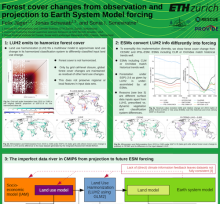Imperfect transfer of land cover / land use change signals from observations and projections into ESMs
Felix
Jäger
Institute for Atmospheric and Climate Science, ETH Zurich, Zurich, Switzerland.
Poster
Land cover and land use matter for near-surface climate. With its biochemical and biophysical properties it can influence local, remote and global climate, also extreme events. Historically, land cover and land use substantially changed, mainly under the influence of human development. In the northern mid-latitudes in modern times, in the tropics over the course of the past century, deforestation and agricultural expansion have been the dominating land cover / land use change (LULCC). In Earth System Model (ESM) Intercomparison Projects (e.g. CMIP6) data on historical land use and land cover changes have been harmonized with socio-economic projections of 21st century LULCC within the Land Use Harmonization (LUH) effort. This is needed because different historical datasets and Integrated Assessment Models (IAMs) employ a variety of land classifications. However, the model employed under LUH (GLM) has not been applied to hamonize forest cover changes, the effort rather focusses on crop- and grassland changes. The output of LUH again is adapted as prescriptive land cover in most ESMs under CMIP6 (again differently depending on the ESM’s native land classes). These imperfect but hard-to-improve steps performed after another lead to forest cover change implemented in ESMs significantly differing from observations or the original information from IAMs respectively. This issue seems to be more pronouced on grid-cell scale but also detectable at regional scale. While such structural uncertainty might not entail deep conceptual problems for most goals of ESM intercomparison projects, these limitations need to be communicated clearly to the broad audience using e.g. the CMIP6 simulations to make sure that the realism of sub-regional scale effects from forest cover change is not overestimated.

Poster file
jaeger-felix-confronting-poster.pdf
(12.17 MB)
